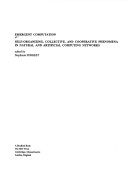A Bradford Book
1 total work
Emergent Computation
Published 21 June 1991
These 31 essays define and explore the concept of emergent computation in such areas as artificial networks, adaptive systems, classifier systems, connectionist learning, other learning, and biological networks to determine what properties are required of the supporting architectures that generate them.Researchers in several fields are exploring computational systems in which interesting global behavior emerges from local interactions among component parts - an approach called emergent computation. In these systems, interactions among simultaneous computations are exploited to improve efficiency, increase flexibility, or provide more realistic models of natural phenomena. These 31 essays define and explore the concept of emergent computation in such areas as artificial networks, adaptive systems, classifier systems, connectionist learning, other learning, and biological networks to determine what properties are required of the supporting architectures that generate them. Many of the essays share the themes of design (how to construct such systems), the importance of preexisting structure to learning and the role of parallelism, and the tension between cooperative and competitive models of interaction. In the introduction, Stephanie Forrest presents several detailed examples of the kinds of problems emergent computation can address. These include showing how emergent computation can lead to efficiency improvements in parallel processing, establishing the connection between emergent computation and nonlinear systems, and comparing two search techniques to show how the emergent-computational approach to a problem differs from other more conventional approaches.
